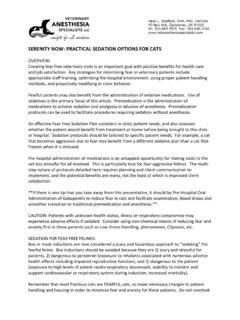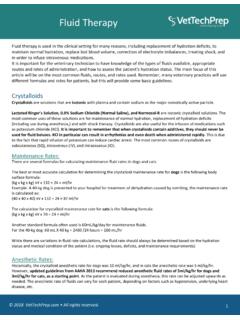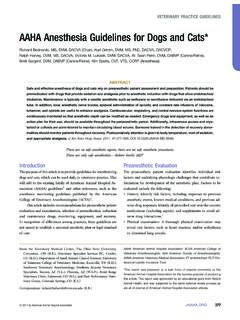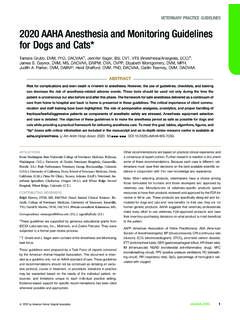Transcription of SERENITY NOW: PRACTICAL SEDATION OPTIONS FOR CATS
1 Heidi L. Shafford, DVM, PhD, DACVAA PO Box 418, Clackamas, OR 97015 Ph: Fax: SERENITY NOW: PRACTICAL SEDATION OPTIONS FOR CATS OVERVIEW: Creating fear free veterinary visits is an important goal with positive benefits for health care and job satisfaction. Key strategies for minimizing fear in veterinary patients include: appropriate staff training, optimizing the hospital environment, using proper patient handling methods, and proactively modifying in-clinic behavior. Fearful patients may also benefit from the administration of sedative medications. Use of sedatives is the primary focus of this article. Premedication is the administration of medications to achieve SEDATION and analgesia in advance of anesthesia .
2 Premedication protocols can be used to facilitate procedures requiring SEDATION without anesthesia . An effective Fear Free SEDATION Plan considers in-clinic patient needs, and also assesses whether the patient would benefit from treatment at home before being brought to the clinic or hospital. SEDATION protocols should be tailored to specific patient needs. For example, a cat that becomes aggressive due to fear may benefit from a different sedative plan than a cat that freezes when it is stressed. Pre-hospital administration of medications is an untapped opportunity for making visits to the vet less stressful for all involved. This is particularly true for fear-aggressive felines.
3 The multi-step nature of protocols detailed here requires planning and client communication to implement, and the potential benefits are many, not the least of which is improved client satisfaction. **If there is one tip that you take away from this presentation, it should be Pre-Hospital Oral Administration of Gabapentin to reduce fear in cats and facilitate examination, blood draws and smoother transition to traditional premedication and anesthesia .** CAUTION: Patients with unknown health status, illness or respiratory compromise may experience adverse effects if sedated. Consider using non-chemical means of reducing fear and anxiety first in these patients such as Low-Stress Handling, pheromones, Clipnosis, etc.
4 SEDATION FOR FEAR FREE FELINES: Box or mask inductions are now considered a scary and hazardous approach to sedating the fearful feline. Box inductions should be avoided because they are 1) scary and stressful for patients, 2) dangerous to personnel (exposure to inhalants associated with numerous adverse health effects including impaired reproductive function), and 3) dangerous to the patient (exposure to high levels of potent cardio-respiratory depressant, inability to monitor and support cardiovascular or respiratory system during induction, increased mortality). Remember that most fractious cats are FEARFUL cats, so make necessary changes to patient handling and housing in order to minimize fear and anxiety for these patients.
5 Do not overlook PRACTICAL SEDATION OPTIONS FOR CATS by HL Shafford 2015 2 the possibility that pain may be contributing to a cat s fear of being handled. Consider a multi-step SEDATION approach that includes an analgesic, detailed below, to facilitate pre-anesthetic SEDATION and help to avoid box inductions in cats. MULTI-STEP SEDATION FOR FEARFUL FELINES: Step 1: Pre-medicate the Cat at Home Indications: fear-aggressive cats, high-anxiety cats. When indicated, at-home administration of sedative, analgesic or anti-anxiety medications can reduce the stress of travel, and decrease the cat s fear wind up upon arrival at the hospital. With the following protocols, the goal is to reduce stress; do not expect overt SEDATION .
6 Caution: avoid pre-hospital SEDATION if you are not sure of the patient s health status, the cat is sick or has respiratory compromise. At-home SEDATION OPTIONS (choose one if pre-hospital SEDATION is indicated) 1. Gabapentin (50 100 mg per cat or 150 mg if big cat, PO, 2 3 hours before arrival) Sprinkle the gabapentin powder on 1 TBS wet food and add flavor enhancer (eg, FortiFlora, tuna juice, etc). I do not have reservations about having a feline patient eat 1 TBS of wet food several hours prior to an anesthetic event. Dose for petite or geriatric cats: reduce dose to 50 mg per cat NB: The sedative dose (>20 mg/kg) is higher than the analgesic dose of gabapentin in cats (gabapentin for analgesia in cats = 5 10 mg/kg or 25 50 mg per cat, PO, BID) The use of pre-hospital gabapentin has been the single most effective tool for reducing fear and anxiety in healthy cats that I and many clinicians have used.
7 Expect that cats will be ataxic and slow but not overtly sedate on this dose of gabapentin. Prepare owners for this!! The sedative effect lingers for ~12 hours and will contribute to woozy behavior and risk of falling after the cat has returned home. No stairs, no jumping, no driving for cats on sedative doses of gabapentin. Gabapentin has analgesic effects in cats, and reducing pain may be one of the ways it helps reduce fear. Gabapentin is typically used prior to SEDATION /premedication protocols (see below). Gabapentin does not replace in-clinic SEDATION /premedication protocols. -or- 2. Buprenorphine ( mg/kg, oral transmucosal, 60 90 min before travel/arrival) -or- 3.
8 Buprenorphine ( mg/kg, oral transmucosal) AND injectable Acepromazine ( mg/kg, oral transmucosal) 2 hours before travel/arrival -or- 4. Lorazepam ( mg/kg, PO 1 hours before travel/arrival) These medications should not be relied upon as a sole pre-anesthetic protocol prior to anesthesia because patients may not be as sedate as desired for catheter placement, IV induction and smooth transition to inhaled anesthesia . Proceed with Steps 2 and 3 to minimize stress/anxiety and achieve adequate in-clinic and pre-anesthetic SEDATION . PRACTICAL SEDATION OPTIONS FOR CATS by HL Shafford 2015 3 Step 2: Minimize Stress for Fearful Felines Upon Arrival at the Veterinary Hospital Communicate to the owner that transportation in a soft squeezable carrier (preferred) or clip-top carrier will facilitate low-stress handling.
9 Move patient in carrier to a QUIET, DARK room immediately upon arrival. Consider covering the carrier with towels that have been sprayed with Feliway . Steps 2 and 3 of Multi-step SEDATION can and should be instituted even if Step 1 cannot be achieved or if cat is not a good candidate for pre-hospital SEDATION . Steps 2 and 3 are appropriate for all cats, even those that are apparently chill cats. Many cats hide their stress and can have a short and unpredictable tolerance for scary procedures in the clinic. Step 3: Low-Stress Handling to Achieve an IM Injection. Use low-stress handling techniques in a quiet environment to perform a physical examination and restrain for injections or blood draw.
10 For feline patients that are too fearful for safe handling, the following tips are helpful: With the soft fabric carriers it is often possible to gently squeeze the cat in the carrier and administer an IM injection through the carrier. For patients in clip-top carriers, slip a thick towel between the top and bottom halves of the carrier so that the cat may be restrained under the towel for an IM injection. Choose one of the following OPTIONS , combine medications in one syringe and administer IM. Hydromorphone ( mg/kg, IM) or Morphine ( mg/kg, IM) or Methadone ( mg/kg, IM) + Dexmedetomidine (7 10 micrograms/kg, IM) Butorphanol ( mg/kg, IM) + Midazolam ( mg/kg, IM) + Acepromazine ( mg/kg, IM) Butorphanol ( mg/kg, IM) + Dexmedetomidine (3 7 micrograms/kg, IM) + Acepromazine ( mg/kg, IM) Can add Alfaxan (2 mg/kg, IM) or Ketamine (1 2 mg/kg, IM, maximum 10 mg per cat) to one of these OPTIONS to achieve heavier SEDATION , or as an additional IM injection if chemical restraint is inadequate after 15 minutes.



